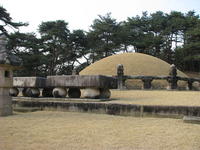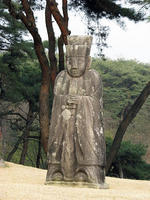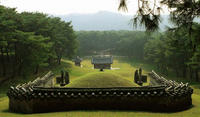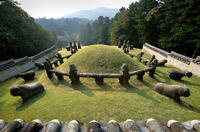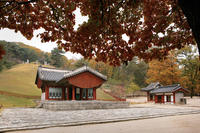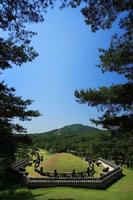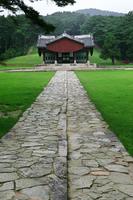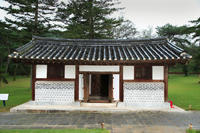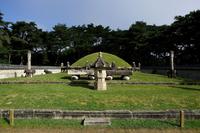You are in: Asia -> Korea, Republic of -> Royal Tombs of the J... , and traditional search or Image Gallery will yield results of this site only
Royal Tombs of the Joseon Dynasty
| Site number: | 1319 |
|
| Type of site: | Cultural | |
| Date: | 1408 - 1966 | |
| Date of Inscription: | 2009 | |
| Location: | Asia, Republic of Korea, 40 kilometers from Seoul | |
Up to 75 images are shown here. Click on each for more details or on Image Gallery for more images.
| Description: | "The Royal Tombs of the Joseon Dynasty form a collection of 40 tombs scattered over 18 locations. Built over five centuries, from 1408 to 1966, the tombs honoured the memory of ancestors, showed respect for their achievements, asserted royal authority, protected ancestral spirits from evil and provided protection from vandalism. Spots of outstanding natural beauty were chosen for the tombs which typically have their back protected by a hill as they face south toward water and, ideally, layers of mountain ridges in the distance. Alongside the burial area, the royal tombs feature a ceremonial area and an entrance. In addition to the burial mounds, associated buildings that are an integral part of the tombs include a T-shaped wooden shrine, a shed for stele, a royal kitchen and a guards’ house, a red-spiked gate and the tomb keeper’s house. The grounds are adorned on the outside with a range of stone objects including figures of people and animals. The inscription of the Joseon Tombs completes the two earlier series of Korean Peninsula royal tombs already inscribed on UNESCO’s World Heritage List: the Gyeongju Historic Areas, Republic of Korea, and Complex of Koguryo Tombs, Democratic People’s Republic of Korea." --WHMNet paraphrase from the description at WHC Site, where additional information is available. | |
| The Royal Tombs of the Joseon Dynasty are a group of tombs of members of the Korean Joseon Dynasty (1392-1910). The tombs have been registered as a UNESCO World Heritage site since 2009.The tombs are classified into two types. Tombs of the kings and queens and those posthumously granted the title of king or queen, were interred in Neung-type tombs. Crown Princes and their wives, as well as the parents of royalty, were interred in Won-type tombs. The royal tombs are scattered over 18 locations, with many of them located 40 kilometers from Hanseong (present-day Seoul). However, the Jangneung tomb is in Yeongwol County, Gangwon-do, while the Yeongneung tombs are in Yeoju County, Gyeonggi-do. Tombs were made for individuals as well as family groups. There are 40 Neung-type tombs and 13 Won-type tombs, thus creating a total of 53 royal tombs. Joseon-era royal tombs followed the guidelines outlined in Chinese Confucian texts, such as the Book of Rites (Li Ji) and the Rites of Zhou (Zhou Li). Many factors went into consideration when deciding the location of a tomb, such as the distance from Hanyang, the distance in relation to other royal tombs, the accessibility of the location, and Korean traditions of pungsu (geomancy). The tomb construction also took into account traditional burial rituals of Korea and the natural environment. This cluster of tombs represents the best sample of royal family group tombs from the Joseon Dynasty. Seven kings and ten queens are interred in nine Neung-type tombs. Famous tombs in this group include the Geonwolleung tomb for King Taejo, the founder of the Joseon Dynasty. The Gyeongneung tomb holds the remains of King Hyeonjong, who ruled from 1834 to 1849, and his wives Queen Hyohyeon and Queen Hyojeong. This group of tombs represents the evolution of Joseon-style tomb architecture over a period of five hundred years. Gwangneung is located in Namyangju City, Gyeonggi Province. The tomb contains the remains of King Sejo and his wife Queen Jeonghui. The two tombs were built in 1468 and 1483 respectively. Gwangneung is important because changes taking place in the construction of royal tombs are evident in its construction. Screening rocks were not installed at this tomb. Instead of an outer coffin stone, quicklime was used instead. Another break from tradition was the fact that the reverential access was not built. Finally, only one T-shaped ritual shrine was built for both burial mounds. This change in tomb architecture came from the last wishes of the king and reflects a new frugal style that influenced later royal tomb construction. --Wikipedia. Text is available under the Creative Commons Attribution-ShareAlike License. | ||
| Source: | http://whc.unesco.org/en/list/1319 | |
| Reference: | 1. UNESCO World Heritage Center, Site Page. | |








